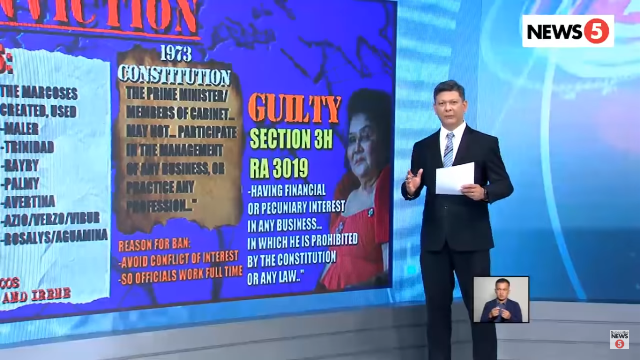Imelda’s Graft Conviction: Knowledge of Legal Procedures a Must in Reporting the Case

Screengrab from News5 Everywhere’s Youtube account.
MEDIA’S EYES may have been on Imelda Marcos, but reports may have missed the legal issues.
The Sandiganbayan 5th division found former First Lady and incumbent Ilocos Norte 2nd District Representative Imelda Marcos guilty of seven counts of graft. The Court said that the former First Lady funneled an estimated $200 million worth of public funds into seven Swiss foundations that she and her husband created when she was governor of Metro Manila, member of the Batasang Pambansa, and Minister of Human Settlements. The decision was promulgated last November 9.
The verdict was significant because none of the Marcoses seemed to have been affected by the various cases in court filed against Ferdinand or Imelda Marcos. Mrs. Marcos has been free to run for elections and sit as a representative in Congress. Both their children Imee and Bongbong Marcos have enjoyed electoral victories.
Online and broadcast media treated the decision as breaking news, referring to the text of the decision. But the high-profile case had many legal and technical issues that were only loosely discussed in reports. Reporters did not ask the kind of questions that would help weigh the judicial actions, including the grant of bail, which followed the promulgation.
CMFR monitored the top three broadsheets (Philippine Daily Inquirer, The Philippine Star, Manila Bulletin), four primetime news programs (ABS-CBN 2’s TV Patrol, GMA-7’s 24 Oras, TV5’s Aksyon and CNN Philippines’ News Night) and selected online news sites from November 9 to 18.
A Decades-long Case
Earliest reports on November 9 in primetime TV explained the decision of the court in detail. The private Swiss foundations were found to have been used for the Marcoses’ benefit, and Imelda Marcos is sentenced to imprisonment from six years and one month to eleven years per count of graft, and perpetual disqualification from public office. Reports pointed out that the decision is not yet final and executory, which means that Mrs. Marcos, who filed her certificate of candidacy for the office of Ilocos Norte governor, can still run for that office in the 2019 elections.
TV Patrol, 24 Oras and Rappler included the same information on November 9. Aksyon pointed out Mrs. Marcos’ previous conviction on November 14.
Among print reports, only Inquirer’s “In the Know” on November 10 provided a backgrounder on the charges filed against Mrs. Marcos from back from 1991 to 1995. The piece said, “Mrs. Marcos was convicted in two criminal cases in 1993 for entering into a lease contract with the Light Rail Transit Authority, Philippine General Hospital and Transnational Construction Corp. that were deemed unfavorable to the government. The guilty verdicts were reversed by the Supreme Court (SC) in 1998.”
Absent at Hearing but Well-enough to Party?
Reports took a detour with the absence of Mrs. Marcos when the decision was issued on this case. Neither did Robert Sison, her legal counsel, appear in court. The Sandiganbayan said this absence was “unjustified,” ordering the forfeiture of her original bail bond and the issuance of an arrest warrant.
The media gave much space and time to this issue, pointing out that Imelda Marcos was able to attend the birthday party of her daughter Imee in the evening and keeping up as Mrs. Marcos changed alibis for her absence during the promulgation.
But reports did not discuss why the unjustified absence matters; except for Rappler and Philstar.com which explained that under Rule 120 of the Rules of Court, unjustified absence may cost Marcos post-conviction remedies like bail.”
Inquirer and GMA News Online said this rule also allows her to justify her absence through a “motion for leave of court” to avail of remedies, including pursuing appeal, seeking deferment of arrest and applying for postconviction bail.
Reports said she filed such motion on November 12, attaching with it a medical certificate explaining her ailments. But according to the Inquirer, the copy of her four-page motion was shown to journalists only on November 15.
Out on Bail
On November 16, Marcos posted PHP150,000 bail. The court granted her temporary freedom while it decides on the motion she filed on November 12 to avail of post-conviction remedies.
Critics were quoted in several reports saying that letting her out on bail was indicative of the double standard of the justice system, and that the amount was too small for the wealth the Marcoses have amassed. But merely recording such reactions did not clarify the basis for granting this temporary freedom to Mrs. Marcos. No one pointed out whether she deserved post-conviction remedies.
Not much has been going on in the news after Imelda Marcos posted bail before the Sandiganbayan 5th division. Many questions on the case are still lingering in the public mind.
Clearly, reporters were not familiar enough with the rules or legal procedures for them to even ask sources pointed questions.
Former Supreme Court chief justice Artemio Panganiban shed light on several issues in Marcos’ guilty conviction. His article “Imelda convicted, but why only now?” published in the Inquirer last November 25 explained why the case took so long to reach a verdict, citing reasons such as “inhibitions of former ponentes” and “postponements asked by both the prosecution and defense.”
Panganiban clearly and concisely provided answers to other questions: “Why was she not jailed after being convicted? Why was she granted bail? Why was her ill-gotten wealth not forfeited? Why was she convicted only of graft? Why not of plunder, a nonbailable offense, given the enormous amounts involved?” Readers and reporters would do well to refer to this opinion piece in understanding the conviction of Imelda Marcos.
Leave a Reply